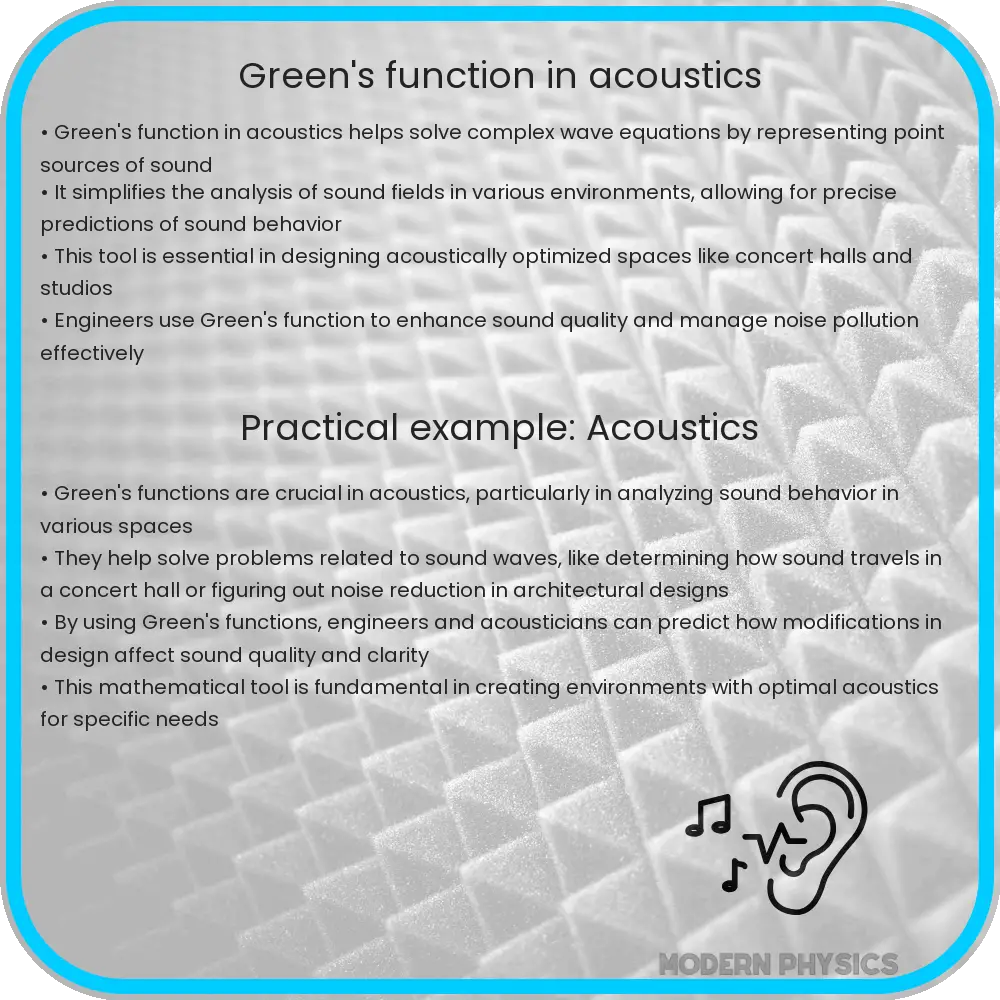Understanding Green’s Function, a mathematical tool for analyzing sound wave behavior and solving acoustics problems in various environments.

Understanding Green’s Function in Acoustics
In the field of acoustics, understanding how sound waves move and interact within different environments is crucial for numerous applications, from designing better concert halls to noise control in urban areas. One powerful mathematical tool used to analyze wave propagation and solve related problems is the Green’s function. This concept not only helps in simplifying complex differential equations but also provides significant insights into the behavior of sound waves under various conditions.
Wave Analysis in Acoustics
Sound waves are a type of mechanical wave consisting of oscillations of pressure transmitted through a medium (such as air, water, or solid materials). Wave analysis involves understanding how these oscillations behave when subjected to different environments or obstacles.
In mathematical terms, sound wave propagation can typically be described by the wave equation, which is a second-order partial differential equation. For a homogeneous and isotropic medium, the wave equation in three dimensions without sources is given by:
\[ \nabla^2 p(x, t) – \frac{1}{c^2}\frac{\partial^2p}{\partial t^2}(x, t) = 0 \]
where \( p(x, t) \) is the pressure field, \( c \) is the speed of sound in the medium, and \( \nabla^2 \) is the Laplacian operator.
The Role of Green’s Function
The challenges in solving the wave equation arise primarily when dealing with complex boundary conditions or inhomogeneous media. This is where Green’s function becomes a pivotal tool. Green’s function, \( G(x, x’, t, t’) \), for a given linear differential operator \( L \) and a point source at position \( x’ \) and time \( t’ \), satisfies the following equation:
\[ L G(x, x’, t, t’) = \delta(x – x’)\delta(t – t’) \]
Here, \( \delta \) represents the Dirac delta function, which is essentially a function that is zero everywhere except at zero, where it is infinitely high such that its integral over its entire range is one. Physically, this represents an instantaneous point source of the wave.
The utility of Green’s function lies in its ability to represent the response of the system to a point source. Once Green’s function for a particular system is known, it can be used to compute the response to more general sources by using the principle of superposition. In acoustics, this is invaluable as it allows the calculation of the sound field in a medium due to arbitrary source distributions.
Modeling with Green’s Function
Green’s functions can be used to solve wave equations numerically or analytically. In numerical models, Green’s functions are used to propagate the field from a source to observation points. In analytical approaches, they provide a way to express the pressure field in an integral form over the sources and the boundary conditions, which can then be evaluated given specific situations.
For example, consider a simple case of a sound wave emitted by a small speaker in an open space. By treating the speaker as a point source, one can use the Green’s function for the free space to predict how the sound pressure varies at different points in the space.
To solve practical problems, the properties of the medium and the boundaries (like walls or obstacles) are considered to adapt the Green’s function accordingly. This can get quite complex, especially in irregularly shaped domains or when the medium has varying acoustic properties.
This conceptual framework not only aids in theoretical studies but also has practical implications in various fields such as architectural acoustics, noise control engineering, and the design of musical instruments. By applying the Green’s function approach, engineers and designers can predict acoustic responses more accurately, enhancing audio experiences or mitigating unwanted noise effectively.
Understanding the application of Green’s functions in acoustics thus provides a foundational tool in the arsenal of physicists and engineers, allowing them to model and analyze acoustic problems with greater precision.
Practical Examples and Case Studies
One real-world application of Green’s functions in acoustics is in the design of concert halls. Here, the goal is to optimize sound distribution to ensure that every seat gets a clear and balanced auditory experience. By applying Green’s function in simulations, engineers can predict how sound waves travel through the auditorium and reflect off walls and ceilings. This insight allows them to make informed decisions on the placement of acoustic panels and the shaping of surfaces.
Another pertinent example is in urban planning for noise reduction. By using Green’s functions, planners can simulate how sound propagates in complex urban environments and identify key contributors to noise pollution. Subsequently, they can design noise barriers or implement specific building orientations that significantly reduce the impact of noise on residents.
Educational Implications
In educational settings, Green’s functions provide a powerful visualization tool for students learning about wave dynamics. Through computational models that use Green’s functions, students can see the direct impact of source placement, boundary conditions, and medium properties on wave propagation. This not only aids in a deeper understanding of acoustics but also enhances their problem-solving skills by applying theoretical knowledge to practical situations.
Conclusion
Green’s functions serve as a cornerstone in the field of acoustics, offering profound insights and practical solutions in sound wave analysis. Whether it’s through improving the acoustic quality of public spaces or mitigating urban noise pollution, the versatility of Green’s function is evident. Furthermore, its application extends beyond professional practice into educational realms, providing a dynamic teaching and learning tool in physics and engineering disciplines. As acoustic challenges grow in complexity with advancing urbanization and architectural designs, the role of Green’s functions will only become more pivotal. Understanding and leveraging this tool effectively equips physicists, engineers, and students alike with the capability to tackle various acoustic problems with confidence and precision.
